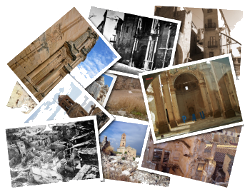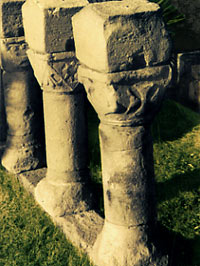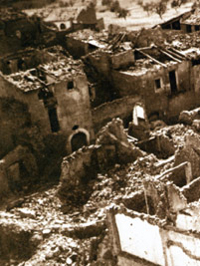
The origin of the place was an iberian town or a protohistoric castle (between the first millennium B.C and the roman conquest).
Further north of the old town, sitting on a hill, the team that made the Archaeological Chart of Catalonia discovered a couple of sites in barren land, forest area on a ridge between two ravines, in which it could be dated between 5500 and 2200 B.C. The state of conservation is bad and there are no remains of architectural structures, although in one is found ceramics superficially.
The explanation lies in its easy access and being areas very affected by the civil war: there are numerous trenches, piles of stones, shelters, shells ... There are also remains of lithic industry carved on flint on some other hill.
All this would be enough to explain the Iberian roots of the toponym that are, according to Enric Aguadé Sans in "Topónimos ibéricos": (KAR / KER / KOR (high rock) + BE (under) + ER (gully) + A (the). KOR-BE-ER- A, has the meaning of gully, under the tall rock. The village is located on the banks of the Sec River, which, through the Sierra del Valle de la Torre, is crowned by bare conglomerate rocks with the same structure as the "montserratines".
Another version is found in the book by Pedro Balañá Abadía "The place names of Catalonia", according to which it would derive from the latin word corvus "place or nest of crows", while the addition of Ebro is derived from the latin Iberus , perhaps from the basque: proper name of place.
This thesis would be supported in heraldry: the crow is the main symbol of the people’s coat of arms, at least from the Middle Ages to the present time. It appears represented in one of the capitals of a gallery of the thirteenth century and which is now exposed inside the old church, on the main facade of the old church (1804), inside a medallion, above the entrance door and the attributes of the chair of St.Peter, patron of the parish and also in the old public wash houses, popularly known as la Font. Some say that they could have their origin in some baths of the Roman period, but the archaeological and/or scientific foundations are missing to support such a claim.
It has been attributed to Corbera an Arab origin, but Juan Agustín Ceán Bermúdez (1749-1829), painter, historian and illustrated critic of Spanish art, believes that Corbera is the ancient Corbion of the Cosetans, nucleus of the Iberian Confederate peoples, allies of the Carthaginians against the Romans. Harassed by Gaius Terentius Varron around 182 BC, during the Second Punic War.
Our ancestors have left us a valuable legacy that often do not know or do not give it the attention it deserves. Many times we have deteriorated our heritage and there has been no social sensitivity needed form any years. During our historical and cultural heritage it has been deteriorated and, in some cases, destroyed.
At last, find out to know a little more our history, the end of the day to recover the collective memory of people is, but the will to assert who we are and where we come to power, solidly, decide to where we want to go.
Medieval
Corbera d'Ebre appears for the first time in a written document in 1153, mentioned in the letter of donation of the Miravet Castle, which was given to the Knights Templar by Ramon Berenguer IV. There is no definite date for the population charter of Corbera, but this was probably towards the end of the twelfth century. It is from this period that the only remains of the castle. The stones of a magnificent gallery whose capitals are decorated with the Templar's Cross are dated.
In 1317 the jurisdiction of Corbera and the rest of bailiwick of Miravet were taken over by the Hospitallers and from then onwards it became of the castellany of Amposta.
Modern
The village is situated in the Riu Sec Valley, between the Cavalls and Fatarella ranges, on the old road to Aragón and is the link with the lowlands of the Ribera d'Ebre. Because of the strategic position it has been destroyed on various occasions.
In 1463, during the war against Joan II, the archbishop of Tarragona, Pere d'Urrea, subdued «in combat and by force of arms» Corbera, supporter of the Generalitat of Catalonia. It also shared with de rest of the region the upsets of the Catalan Revolt (Guerra dels Segadors). During the War of the Spanish Succession, the village was occupied by Franco-Spanish troops on February 6th, 1707.
Contemporary
The Civil War of 1936-1939 brought the greatest disaster in the history of Corbera: during the Battle of the Ebro, the village was in the vanguard of the republican front established in August 1938 on the outskirts of La Pobla de Massaluca, Vilalba and Gandesa. The front crumbled in Corbera on September 3rd and the village was left practically in ruins.
Poble Vell lies on top of a hill at 337 meters; where a multitude of houses in ruins give evidence of what until 1938 was the village of Corbera d'Ebre.There lies his symbol, the Church of San Pedro from where you can see the rugged mountains of the Sierra de Pàndols and Cavalls and much of the land that was the main stage of the 115 days of confrontation that lasted the battle.


